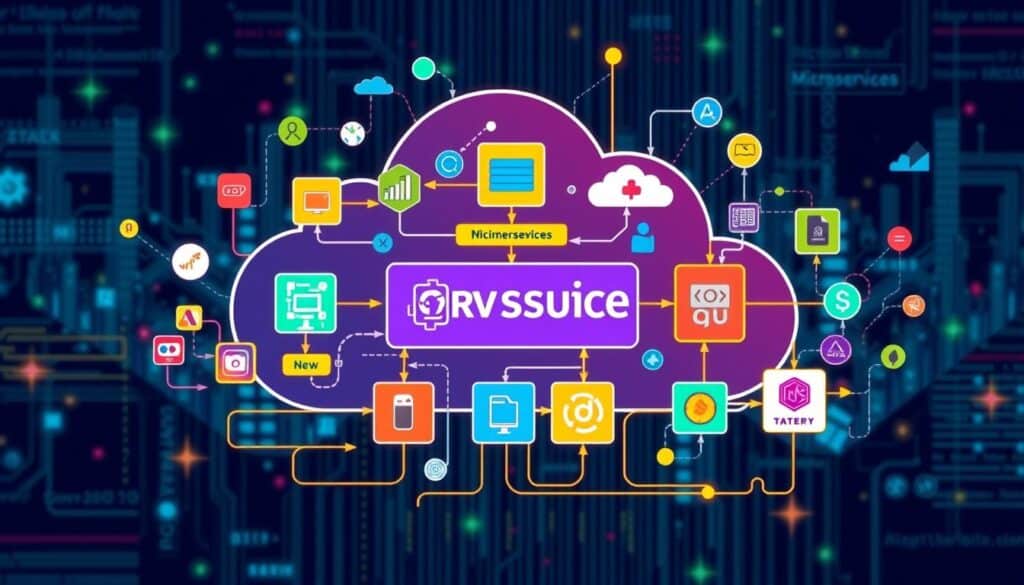
Did you know 85% of large organizations with over 5000 employees adopted microservices in 2021? This big change shows how much microservices have changed software development. It breaks down big apps into smaller, independent services.
This makes apps more scalable and agile. Businesses can quickly adapt to changing market needs.
Microservices bring many benefits for today’s fast-paced development world. They improve fault isolation and offer flexibility in technology. Big names like Netflix and Amazon use them for top-notch performance and reliability.
By splitting apps into separate services, they manage each part better. This means they can use resources more efficiently and keep performance smooth, even when demand is high.
Exploring microservices shows how it’s changing the software world. It helps get new features to market faster and makes maintenance easier. Let’s look at how microservices are becoming key in modern software development.
Key Takeaways
- Microservices allow individual components of applications to scale independently.
- Enhanced fault isolation prevents complete system failure from singular service breakdowns.
- Faster development cycles lead to quicker time-to-market for new features.
- Companies like Netflix and Amazon effectively utilize microservices for high performance.
- Microservices architecture simplifies maintenance and updates without impacting the entire system.
- Scalability and flexibility make microservices ideal for modern software needs.
Introduction to Microservices
In our journey to understand what is microservices architecture, we must first learn where it came from. Microservices break down big software into smaller, independent parts. Each part does one thing, changing how we make and manage apps.
Microservices started from Service-Oriented Architecture (SOA). Unlike old ways of putting everything in one place, microservices spread out and work better together. This makes apps more flexible and easier to update without messing up others.
The move to microservices came from needing apps that grow and stay strong. By breaking into parts, apps can handle problems better. This also lets teams work faster and be more agile.
Microservices make updating apps easier and faster. Teams can try new things and update parts quickly. This is different from old ways where changing one part meant redoing the whole app.
Being able to choose the right tools is key to microservices. Teams pick the best for each part, not just one for everything. This makes each part better and lets teams try new things.
Microservices also make it easier to reuse code. Breaking software into small parts means code can be used in many places. This makes work more efficient and cuts down on waste. Services like Amazon ElastiCache and AWS Lambda show how microservices work well in real life.
Microservices also make it easy to grow or shrink parts as needed. This means apps can handle changes without getting too slow or too busy. This is great for apps that need to change a lot.
But, microservices can be tricky to manage. Keeping everything running smoothly needs constant checking and fixing. Tools like AWS Cloud Map help make sure everything works well together.
Learning about microservices helps us make apps that are strong, growable, and easy to keep up. By being flexible and independent, we can make apps that meet today’s needs and tomorrow’s too.
Key Benefits of Microservices Architecture
Microservices architecture is a new way to build apps by splitting them into smaller parts. These parts can work on their own, focusing on enhanced scalability and better fault isolation. This makes it easier to grow each part as needed, making the system more reliable and less likely to crash.
One big plus is improved fault isolation. This means if one part fails, it won’t bring down the whole app. This is key for keeping apps stable and improving how they handle problems. For instance, Netflix moved to microservices and saw big gains in performance and speed.
Another great thing is technology flexibility. With microservices, developers can pick the best tech for each part. This encourages creativity and innovation. It also helps attract top talent and boosts productivity and ROI.
Microservices also make it easier to update and maintain apps. You can change one part without affecting the whole system. This makes adding new features smooth and quick, fitting well with Agile and continuous deployment.
Also, microservices make it easy to scale services up or down as needed. This is super important in today’s fast market. It lets companies quickly meet customer needs and provide great experiences. Plus, they support secure APIs, helping meet data security standards like GDPR and HIPAA.
Overall, microservices help businesses build apps that are efficient, secure, and scalable. For more details, check out Atlassian’s microservices guide.
Real-World Examples of Microservices in Action
Looking at real-world examples of microservices shows how big companies stay agile and scalable. Netflix is a great example. It uses microservices for tasks like charging users and delivering content. This way, it can add new features smoothly without any problems.
Amazon is another example of scalability with microservices. It updates its system over 50 million times a year without affecting customers. This shows how efficient and dynamic Amazon’s approach is.
Uber also uses microservices to improve its service. It connects drivers and passengers through a REST API and MySQL databases. This makes Uber’s system flexible and able to adapt quickly to changes.
Microservices help ecommerce sites too. Walmart, for example, saved a lot on hardware and power after switching to microservices. This shows how microservices can make things more efficient.
Spotify and PayPal are also good examples. Spotify uses microservices to keep its service consistent for over 75 million users. PayPal, on the other hand, handles over a billion hits daily with its Node.js microservices. Both show how well microservices can scale and focus on customers.
Uber and Amazon are just a few examples of companies that have successfully adapted to microservices. As multiple sources show, big companies benefit from microservices’ ability to be deployed and tested independently. This leads to better scalability and resilience.
Switching to microservices also makes systems more agile and reduces risks. Problems like memory leaks are limited to one service, avoiding big disruptions. This flexibility helps tech stacks be more innovative and effective.
| Company | Key Benefit | Technology |
|---|---|---|
| Netflix | Seamless Feature Deployment | Microservices |
| Amazon | Scalability and Rapid Updates | Microservices |
| Uber | Enhanced Flexibility | Microservices and REST API |
| Spotify | Consistency in User Experience | Microservices |
| PayPal | Scalability and Efficiency | Node.js and Microservices |
Challenges and Considerations
Switching to microservices is good but comes with many challenges. One big issue is handling the increased complexity of managing service connections and keeping data consistent. About 62% of companies struggle with these tasks.
Companies like Uber show how microservices can handle complex tasks well. But, they also face problems keeping data correct. They use special strategies to avoid system failures, showing the need for advanced management.
Google’s Site Reliability Engineering (SRE) focuses on culture to handle microservices’ complexity. Spotify’s squads managing complex tasks offer a good example. They show how to deal with the complexity of microservices.
- Communication Patterns: Using REST, message queues, and event-driven architecture is key for service communication.
- Data Management: Strategies like polyglot persistence, event sourcing, and CQRS help manage data.
- Monitoring Systems: Tools like Jaeger or Zipkin are good for tracing and monitoring distributed systems.
- Service Orchestration vs. Choreography: Finding the right balance between these approaches is important.
- Containerization and Orchestration: Docker and Kubernetes are crucial for deployment and DevOps.
Good testing strategies, like integration and end-to-end testing, are vital. Security can be improved with a zero-trust model and API standards like OAuth2 and JWT. API gateways also help control access.
Scalability and resource management are big challenges. Tools for container orchestration and auto-scaling based on metrics help. Versioning strategies ensure services work together smoothly.
Dealing with organizational complexity and communication issues is key. A culture of open communication and teamwork helps. Teams need experience with distributed systems and service mesh to communicate well.
Designing for resilience is crucial to avoid system failures. A DevOps culture is needed for agile businesses to quickly deploy services. Finding the right balance between fast deployment and continuous delivery is hard but necessary.
| Challenge | Description | Solutions |
|---|---|---|
| Data Consistency | Maintaining data integrity across services. | Event sourcing, CQRS, polyglot persistence. |
| Operational Complexity | Managing numerous services and ensuring robust operations. | SRE practices, circuit breakers, fallback mechanisms. |
| Testing and Monitoring | Ensuring effective testing and monitoring frameworks. | Integration testing, contract testing, Jaeger, Zipkin. |
| Security | Mitigating security risks. | Zero-trust model, OAuth2, JWT, API gateways. |
| Scalability | Efficient resource allocation and scaling. | Container orchestration, auto-scaling, versioning strategies. |
Microservices offer many benefits but come with complex challenges. Effective planning, strong tools, and a culture of innovation are essential to overcome these hurdles.
Key Aspects of Microservices Architecture
Understanding the core principles of microservices is key. Microservices focus on independent components. Each can be developed, deployed, and scaled on its own. This lets small teams work on different parts of the system.
Another important point is decentralized data management. This means each service handles its own data. This reduces bottlenecks and makes the system more resilient.
Effective microservices best practices include using the right architectural styles and communication models. This makes sure services work well together. Practices like continuous integration and continuous delivery (CI/CD) are also important. They let new features and updates be added quickly without harming the system.
Using different communication models, like synchronous HTTP/REST or asynchronous messaging queues, makes service interactions more efficient and flexible.
A big part of microservices architecture is designing for resilient software design. This means breaking down applications into smaller, easier-to-manage pieces. It also means isolating faults so one service’s failure doesn’t spread to others.
It’s also crucial to have good ways to monitor service health. This includes log aggregation, distributed tracing, and health checks. Using generative AI can help automate deployment strategies and improve fault tolerance. This makes microservices not just scalable but also more reliable.
FAQ
What is microservices architecture?
Microservices architecture breaks down big software into smaller, independent services. Each service does one thing. This makes big apps more flexible and scalable.
What are the key benefits of microservices architecture?
Microservices make apps more scalable and easier to update. They also improve fault isolation and allow for agile development. This means apps can grow without crashing and teams can pick the best tech for each service.
How do companies like Netflix and Amazon utilize microservices?
Netflix and Amazon use microservices to manage big operations well. They split their apps into smaller services for better performance and agility. This helps them grow and innovate fast.
What are some challenges associated with microservices?
Microservices bring benefits but also challenges. They add complexity and can cause data issues. They need good monitoring and testing. Managing them well is key to smooth operation.
How does microservices architecture enable improved fault isolation?
Microservices isolate faults in one service, not affecting others. This makes systems more resilient and less likely to fail. It helps apps grow and stay strong.
What are some real-world examples of microservices in action?
Netflix, Amazon, and Uber use microservices to boost their systems. They scale services independently and innovate fast. This shows how microservices work well in practice.
How do you handle data consistency in microservices?
Data consistency in microservices is tricky because services are spread out. Use models like eventual consistency and strong messaging. Also, log and monitor data well to keep it consistent across services.
What are the core principles of microservices architecture?
Microservices rely on independent components, decentralized governance, and resilient design. These principles help integrate services well, use resources efficiently, and adapt quickly. This ensures apps are scalable and perform well.
Future App Studios is an award-winning software development & outsourcing company. Our team of experts is ready to craft the solution your company needs.










